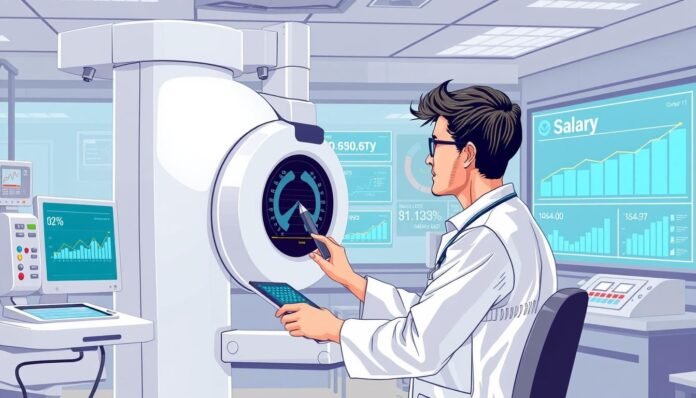The healthcare industry needs skilled radiologic technologists more than ever. These pros play a key role in medical imaging. They help doctors and patients with their vital work—X-ray tech salary.
Let’s look at the average pay for this sought-after job. We’ll explore what radiologic technologists can expect to earn.
A detailed illustration of a radiologic technologist in a modern hospital setting, operating an X-ray machine, surrounded by medical equipment, with graphs and charts showing salary statistics in the background, showcasing a blend of professionalism and advanced technology.
Radiologic technologists run special imaging tools, such as X-ray and CT machines. They take clear pictures to help doctors treat many health issues.
Their work is crucial, so they earn good pay. The healthcare field values their skills highly.
Understanding the Role of an X-Ray Technician
X-ray techs operate equipment to capture images of the human body. These images help doctors identify and treat various medical conditions.
X-ray technicians position patients and adjust equipment for quality images. They are also known as radiologic technologists.
Becoming an x-ray tech requires completing an accredited education program. This involves a two-year associate’s or four-year bachelor’s degree in radiologic technology.
Students learn anatomy, radiation physics, patient care, and imaging techniques. After graduating, x-ray techs must pass a national exam for certification.
X-ray technicians prepare rooms, sterilize equipment, and ensure patient safety. They keep detailed records and communicate with healthcare providers about results.
Continuous learning is crucial in this field. New technologies and techniques are constantly emerging.
Factors Influencing X-Ray Tech Salary
X-ray tech salaries vary based on several key factors. Geographic location plays a significant role in determining pay rates.
Urban areas and regions with higher living costs often offer better salaries, which helps healthcare providers attract and retain skilled professionals.
Experience level significantly impacts earning potential. Entry-level positions typically start with lower pay.
Seasoned professionals with years of experience can earn much higher salaries. Your work setting also affects your pay as an x-ray tech.
Hospitals, clinics, and outpatient facilities may offer different salaries. Specialized imaging centers might pay more for specific skills.
Knowing these factors can help you make wise career choices. It can also improve your ability to negotiate better pay.
Average X-Ray Tech Salary in the United States
X-ray technician salaries vary across the United States. The national average salary for radiologic technologists is about $61,900 per year.
California offers one of the highest average salaries at over $77,000 yearly. Mississippi and Arkansas have lower salaries, often around $50,000 annually.
X-ray tech salaries have recently seen modest yearly increases. The job outlook remains positive, with 9% growth projected over the next decade.
Salary Range for Entry-Level X-Ray Technicians
New x-ray tech grads can expect to earn around $50,000 per year. The job market for recent graduates is promising.
Starting pay can vary based on location and workplace type. Urban areas and specialized settings often offer higher salaries.
Entry-level salary is just the beginning. Your earning potential can grow with experience and extra certifications.
Knowing the typical salary range helps you prepare for your career and allows you to negotiate your pay with confidence.
Salary for Experienced X-Ray Technicians
Experienced X-ray technicians see a steady rise in their pay. Their average salary in the US is much higher than that of entry-level jobs.
This reflects the extra skills and duties they have gained over time. Career growth is a big reason for higher pay.
Technicians often take on more specialized or supervisory roles. They may also get advanced certifications that lead to better pay.
The x-ray tech field offers excellent chances for earning more. Experienced pros often make 30-50% more than beginners.
Location, industry, and employer also affect pay. High-demand areas and unique healthcare settings often pay more.
Hospitals and radiology clinics tend to offer higher salaries compared to more general roles or lower-paying areas.
Specializations and Their Impact on Salary
Radiologic technologists can boost their earning potential through specialized certifications. X-ray tech specializations open doors to high-paying medical imaging roles.
Becoming a certified CT or MRI technologist can increase your salary. These specialties require extra training, making them highly valued.
Certifications in mammography, cardiac catheterization, or radiation therapy lead to higher-paying positions. These skills are in demand in the healthcare industry.
A diverse group of radiologic technologists in a modern medical facility showcases various specializations such as MRI, CT scan, and mammography. Each is engaged in specialized tasks with advanced imaging equipment, a bright and sterile environment, and a detailed focus on technology and teamwork.
Management or leadership certifications can also enhance your salary prospects. As an x-ray tech, you may transition into supervisory roles.
These positions typically come with a higher pay scale. Developing your skills can unlock new career paths in medical imaging.
Benefits and Perks of Being an X-Ray Technician
X-ray techs enjoy more than good pay. They also enjoy great benefits and a nice work-life balance.
These perks make it a rewarding healthcare job. X-ray techs receive health insurance and retirement plans.
Radiologic technologists often work regular hours. This allows them to balance work and personal life well.
Many places offer flexible schedules. X-ray techs can work part-time or as needed.
X-ray tech benefits usually include medical, dental, and vision coverage. They also get retirement savings plans like 401(k)s or pensions.
These perks help techs stay healthy. They can also plan for a sound financial future.

Job Outlook for X-Ray Technicians
X-ray technicians have a bright future ahead. The US Bureau of Labor Statistics predicts a 9% growth from 2019 to 2029.
This growth is faster than the average for all jobs and is driven by increased demand for diagnostic imaging services.
The aging population needs more medical care, and new technologies like MRI and CT scans expand radiologic technologists’ roles.
Advanced equipment creates a need for skilled X-ray technicians. Healthcare facilities are also looking to replace retiring technicians.
Many baby boomers are retiring from X-ray tech jobs, opening positions for new professionals.
The x-ray tech job market offers many opportunities. It’s a promising career choice for those interested in medical imaging.
How to Negotiate Your X-Ray Tech Salary
Negotiating your salary is vital for x-ray technicians. It’s key to your career growth and financial well-being.
Research average x-ray tech salaries in your area. Consider your experience, skills, and local cost of living.
Highlight your unique qualifications when discussing pay. Show the value you bring to the organization.
Choose the right time to talk about your salary. Annual reviews are often good opportunities.
Be positive and focus on your contributions. Show how fair pay helps you provide excellent patient care.
Aim for a win-win solution in salary talks. Be professional and solution-oriented to get the pay you deserve.
Comparing X-Ray Tech Salary with Other Medical Careers
Radiologic technologist salaries compare well to other healthcare roles. This comparison offers insights into earning potential and career prospects.
The average salary for radiologic technologists is about $60,000 per year, similar to or higher than that of many other allied health professions.
Salaries can vary based on specialization, experience, and location. Advanced imaging specialists often earn more than essential X-ray technicians.
Experienced technologists usually earn more than entry-level professionals. Understanding these factors helps in making informed career decisions.
Salary is significant, but there are other factors to consider. Find a job that matches your interests and provides personal satisfaction.
Your career choice should align with your values and long-term goals. Consider all aspects when deciding on a career as a radiologic technologist.
Continuing Education and Salary Growth
X-ray tech professional development can boost your career and salary—radiologic technologists who invest in education open doors to better opportunities.
Staying current with new tech and rules makes you more valuable. Many employers support x-ray technicians in getting more certifications and training.
Continuous learning can lead to promotions and higher pay. It also improves job satisfaction and career fulfillment.
As you gain knowledge, you become more confident and skilled. This can result in job security and growth in radiologic technology.
Resources for X-Ray Technicians Looking for Salary Insights
X-ray technicians need to know about industry trends and salary benchmarks. Online resources can help you learn about x-ray tech salaries.
The American Society of Radiologic Technologists (ASRT) offers valuable salary data. Their yearly survey breaks down pay by experience, specialization, and location.
This resource helps you understand the market rate for your skills. It can guide your career growth and financial planning.
Online salary calculators are also helpful for x-ray technicians. Websites like Salary.com and PayScale estimate your earning potential.
You can input your job title, location, and other details. These tools help you compare your salary and find growth areas.
FAQ
What is the average salary for an X-ray technician?
In 2020, the median yearly pay for radiologic technologists was $61,900. Pay can change based on location, experience, and specialization.
What education and certification do I need to become an X-ray technician?
Most X-ray techs have a two-year associate’s degree in radiologic technology. They must also be licensed and pass the ARRT exam.
What factors affect the salary of an X-ray technician?
Location, experience, and skills can affect an X-ray tech’s pay. The type of healthcare facility they work in also matters.
How does the salary for an entry-level X-ray technician compare to an experienced one?
New X-ray techs earn around $55,000 yearly, while experienced techs with over 10 years of experience can make about $70,000.
What are some high-paying X-ray technician specializations?
Specializing in heart imaging, mammography, or CT scans can boost pay. These roles can earn $65,000 to $75,000 or more yearly.
What are the typical benefits and perks for X-ray technicians?
X-ray techs often get health insurance and retirement plans. They may also receive paid time off and chances to learn.
What is the job outlook for X-ray technicians?
The job outlook for X-ray techs is good. Jobs are expected to grow 9% from 2020 to 2030.
How can X-ray technicians negotiate their salaries?
X-ray techs should research pay rates and highlight their skills. They can also discuss benefits and growth chances.
How does the salary of an X-ray technician compare to other medical careers?
X-ray techs earn more than medical assistants and EMTs. But they make less than sonographers and radiation therapists.
How can X-ray technicians continue to grow their salaries?
Getting more certifications and training can boost pay. Taking on leadership roles can also help increase earnings.
You may also read: Radiology Tech Salary: Your Guide to Annual Earnings
